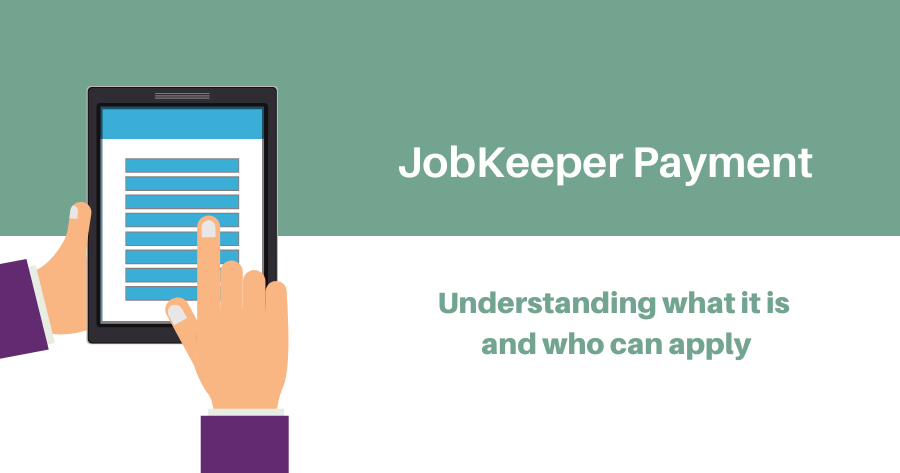EMPLOYERS- JobKeeper FAQs

Economic Response to COVID
April 2, 2020
Potential Consequences of Early Release of Super
April 23, 2020WHAT IS THE JOBKEEPER PAYMENT?
The JobKeeper Payment is a payment made to eligible businesses and not-for-profits affected by the Coronavirus to support them in retaining employees.
Eligible businesses that elect to participate will receive a payment of $1,500 per fortnight per eligible employee to support the people they employed as at 1 March 2020 who are retained in employment.
Businesses must have paid their employees before they are entitled to receive the JobKeeper payment. Where an employee’s total remuneration is less than $1,500 per fortnight (before tax), or has been stood down, the employer must provide the employee at least $1,500 per fortnight (before tax). Where an employee earns more than $1,500 per fortnight, employers can use the payment to subsidise the employee’s wages.
Self-employed individuals will also be eligible to receive the JobKeeper payment.
WHEN WILL THE JOBKEEPER PAYMENT COMMENCE?
The JobKeeper Payment will be available from 30 March 2020.
HOW LONG WILL THE JOBKEEPER PAYMENT LAST FOR?
The JobKeeper Payment will be available for the period until 27 September 2020.
Employers
IS MY BUSINESS ELIGIBLE?
Employers (including not-for-profits) will be eligible for the subsidy if:
- their business has a turnover of less than $1 billion (and if part of a group for income tax purposes, the group has a combined turnover of less than $1 billion) and estimate their turnover has fallen or will likely fall by 30 per cent or more; or
- their business has a turnover of $1 billion or more (or if part of a group for income tax purposes, the group has a combined turnover of $1 billion or more) and estimate their turnover has fallen or will likely fall by 50 per cent or more; or
- their business is not subject to the Major Bank Levy.
For charities registered with the Australian Charities and Not-for-profits Commission (ACNC), they will be eligible for the subsidy if they estimate their turnover has fallen or will likely fall by 15 per cent or more relative to a comparable period.
JobKeeper Payments are paid in respect of each eligible employee who was employed at 1 March 2020 and is currently employed by the business (including those who are stood down or re-hired).
WHAT TYPE OF ENTITIES ARE ELIGIBLE?
All business types, including not-for-profits, will be eligible with the exception of those listed below. The following entities will not be eligible:
- Australian Government and its agencies,
- State and Territory governments and their agencies,
- Foreign governments and their agencies;
- Local council governments;
- Wholly-owned corporations of any of the above; and
- A business subject to the Major Bank Levy.
Additionally, a company that is in liquidation, or a partnership, trust or sole trader in bankruptcy, will not be eligible.
Some sectors may not be eligible if they are separately provided with support from the Government that explicitly requires them to forgo access to the JobKeeper Payment.
WHAT DO I NEED TO DO IF I WANT TO PARTICIPATE?
Eligible employers need to determine if they want to participate in this program by electing into it. More details will be provided about how to do that.
The JobKeeper Payment will be administered by the ATO.
If you want to participate, you can register your interest on the ATO website to keep updated on information about the JobKeeper payment.
If you register you will receive updates and information from the ATO about how and when to claim the JobKeeper payment.
If you are a BAS or Tax agent you do not need to register each client separately, unless you are registering each client to receive the information directly.
HOW DO I WORK OUT WHICH OF MY EMPLOYEES ARE ELIGIBLE EMPLOYEES?
You will only be able to claim the JobKeeper payment for eligible employees that were in your employment on 1 March 2020, and continue to be employed while you are claiming the JobKeeper payment.
An eligible employee is an employee who:
- is currently employed by the eligible employer (including those stood down or re-hired);
- is a full-time or part-time employee, or a casual employed on a regular and systematic basis for longer than 12 months as at 1 March 2020;
- was aged 16 years or older at 1 March 2020;
- was an Australian citizen, the holder of a permanent visa, or a Special Category (Subclass 444) Visa Holder at 1 March 2020;
- was a resident for Australian tax purposes on 1 March 2020; and
- is not in receipt of a JobKeeper Payment from another employer.
You can only claim JobKeeper payment for eligible employees if you pay the $1,500 per fortnight (before tax) to each eligible employee.
These payments should be made using your payroll system and reported to the ATO via Single Touch Payroll. This will support the online claim process when it is available.
If you do not report through Single Touch Payroll, you can still claim the JobKeeper payment; however there will be a manual claim process.
You will be required to advise your employees whether you have nominated them as an eligible employee for the purposes of the payment.
WHEN WILL I RECEIVE THE FIRST PAYMENT?
The first payments by the ATO will be received by employers in the first week of May.
HOW OFTEN WILL THESE PAYMENTS BE MADE?
The payments will be made by the ATO monthly in arrears.
WHAT ARE THE ELIGIBLE PAYMENT PERIODS FOR REIMBURSEMENT FOR A JOBKEEPER SUBSIDY?
Employers will need to satisfy payment requirements for their eligible employees in respect of each 14 day period covered by the scheme. The first period starts on Monday 30 March 2020 and ends on
Sunday 12 April 2020.
The payment requirement is that they pay their eligible employees a minimum of $1,500 per fortnight in the scheme payment periods. Where an employer pays their staff monthly, the ATO will be able to reallocate payments between periods. However, overall an employee must have received the equivalent of
$1,500 per fortnight.
The final period will start on Monday 14 September 2020 and end on Sunday 27 September 2020.
IF I HAVE STOOD DOWN MY EMPLOYEES AFTER 1 MARCH 2020, AND ARE NO LONGER PAYING THEM, DO I NEED TO PAY THEM, FOR WHAT PERIOD AND BY WHEN?
Yes. You can claim JobKeeper for employees that were stood down after 1 March 2020. To be eligible in relation to these employees, you will need to pay them a minimum of $1,500 per fortnight (before tax) for the payment periods of the JobKeeper Scheme.
The first payment period under the scheme is from 30 March 2020 to 12 April 2020. Where an employer pays their staff monthly the monthly payment must be equivalent to the required fortnightly payment.
For all following payment periods you will need to continue to pay your employees a minimum of
$1,500 per fortnight (before tax), before the end of the payment period.
WHAT IS THE DEFINITION OF TURNOVER?
Turnover will be defined according to the current calculation for GST purposes and is reported on Business Activity Statements. It includes all taxable supplies and all GST free supplies but not input taxed supplies.
There are some modifications for businesses that are part of a GST group.
Further information on GST turnover, and how to calculate it, is available at ato.gov.au.
IS THIS TURNOVER TEST RELATED TO ONLY TURNOVER IN AUSTRALIA, OR DOES IT INCLUDE OVERSEAS OPERATIONS AS WELL?
Under the GST law, only Australian based sales are included and therefore, only Australian based turnover is relevant. A decline in overseas operations will not be counted in the turnover test.
MY BUSINESS HAS ONLY JUST STARTED OR MY BUSINESS HAS “LUMPY” INCOME. HOW CAN I SELF-ASSESS THAT MY TURNOVER HAS FALLEN 30 PER CENT?
To establish that a business has faced or is likely to face a 30 per cent or more or 50 per cent or more fall in turnover, most businesses would be expected to establish that their turnover has fallen in the relevant month or quarter (depending on the Business Activity Statement reporting period of that business) relative to their turnover in a corresponding period a year earlier.
Where a business was not in operation a year earlier, or where their turnover a year earlier was not representative of their usual or average turnover, (e.g. because there was a large interim acquisition, they were newly established, were scaling up, or their turnover is typically highly variable), the Tax Commissioner will have discretion to consider additional information that the business can provide to establish that they have been adversely affected by the impacts of the Coronavirus.
The Tax Commissioner will also have discretion to set out alternative tests that would establish eligibility in specific circumstances (e.g. eligibility may be established as soon as a business ceases or significantly curtails its operations). There will be some tolerance where employers, in good faith, estimate a 30 per cent or more or 50 per cent or more fall in turnover but actually experience a slightly smaller fall.
MY TURNOVER HAS NOT DECREASED BY 30 PER CENT THIS MONTH, BUT I BELIEVE IT WILL IN THE COMING MONTH. AM I ELIGIBLE?
You can apply for the payment if you reasonably expect that your turnover will fall by 30 per cent or more (or 50 per cent or more for businesses with a turnover of $1 billion or more) relative to your turnover in a corresponding period a year earlier. The ATO will provide guidance about self-assessment of actual and anticipated falls in turnover.
IT IS UNLIKELY THAT MY TURNOVER WILL DECREASE BY 30 PER CENT IN THE COMING MONTH, BUT CAN I APPLY LATER IF MY TURNOVER DECREASES IN ONE OF THE SUBSEQUENT MONTHS?
If a business does not meet the turnover test at the start of the JobKeeper scheme on 30 March 2020, the business can start receiving the JobKeeper Payment at a later time once the turnover test has been met. In this case, the JobKeeper Payment is not backdated to the commencement of the scheme. Businesses can receive JobKeeper Payments up to 27 September 2020.
MY BUSINESS IS STILL OPERATING AND MY EMPLOYEES ARE STILL WORKING. HOW WILL MY PAYMENTS TO THEM BE AFFECTED?
In many cases, your payments and obligations to eligible employees will not change. Your business, if eligible, will receive a $1,500 per fortnight subsidy to support their continued employment. However, if any eligible employee currently earns less than $1,500 before tax per fortnight, you will need to pay them
$1,500 per fortnight before tax to receive the JobKeeper payment.
WHAT IF I PAY MY EMPLOYEES LESS THAN $1,500 PER FORTNIGHT BEFORE TAX?
To be able to claim the JobKeeper payment for an eligible employee, that employee must be paid a minimum of $1,500 income per fortnight, before tax is withheld.
If you want to claim the subsidy for an eligible employee and they have not been paid $1,500 per fortnight since 30 March 2020, employers must pay a ‘top-up’ payment to employees so that they are eligible. The ATO will provide further guidance on how this will work.
The employer will be reimbursed $1,500 per fortnight for each eligible employee.
Employers cannot pay their employees less than $1,500 per fortnight and be entitled to a payment for that employee.
WHAT IF I PAY MY EMPLOYEES MORE THAN $1,500 PER FORTNIGHT BEFORE TAX?
If the eligible employee is paid more than $1,500 a fortnight before tax, the employer will only be reimbursed $1,500 per fortnight.
IF I HAVE STOOD DOWN MY EMPLOYEES WITHOUT PAY AFTER 1 MARCH 2020 CAN I ‘BACK PAY’ THEM TO 30 MARCH 2020?
Yes. If you want to claim the JobKeeper Payment for your employees you will need to confirm your eligible employees want to be part of the scheme and arrange for them to be paid a minimum of $1,500 per fortnight before tax from 30 March 2020.
I LET MY EMPLOYEES GO AFTER 1 MARCH 2020. IF I RE-HIRE THEM, AM I ELIGIBLE TO RECEIVE THE PAYMENT?
Yes. You can receive the payment if you re-hire any eligible employees you had at 1 March 2020. You can receive the payment even if you then need to immediately stand them down, so long as they remain employed.
WHAT HAPPENS IF I DON’T HAVE THE MONEY TO CONTINUE PAYING MY ELIGIBLE EMPLOYEES UNTIL THE PAYMENTS ARE MADE?
The JobKeeper Payment is a reimbursement scheme that will be paid by the ATO monthly in arrears.
In cases where this may present cash flow difficulties, those businesses may want to speak to their bank to discuss their options. The banks have said businesses may be able to use the upcoming JobKeeper payment as a basis to seek credit in order to pay their employees until the scheme is making its first payments.
AM I REQUIRED TO PAY PAYGW AND SUPERANNUATION ON THE JOBKEEPER PAYMENT?
You must pay a minimum of $1,500 per fortnight to your eligible employees, withholding income tax as appropriate. The $1,500 per fortnight per employee is a before tax amount. Where an employee is paid more than $1,500 per fortnight, the employer’s superannuation obligations will not change. Where an employee is having their wages topped up to $1,500 per fortnight by the JobKeeper Payment, it will be up to the employer if they want to pay superannuation on any additional wages paid by the JobKeeper Payment.
WHAT HAPPENS IF MY EMPLOYEE RESIGNS?
If an employee for whom you are receiving the JobKeeper Payment resigns, you must notify the ATO. You may need to refund some money to the ATO.
I HIRED AN EMPLOYEE AFTER 1 MARCH 2020. CAN I RECEIVE THE JOBKEEPER PAYMENT FOR THEM?
No. The employee must have been engaged as of 1 March 2020.
I PURCHASED A BUSINESS IN THE LAST 12 MONTHS AND RETAINED SOME CASUAL EMPLOYEES WHO WORKED FOR THE PREVIOUS BUSINESS OWNER. ARE THE CASUAL EMPLOYEES ELIGIBLE?
Employers must assess whether their casual employees satisfy the test of working for 12 months on a regular and systemic basis. A casual may still meet this condition even if the entity operating the business has changed recently.
I ACCEPTED SOME CASUAL EMPLOYEES FROM ANOTHER MEMBER OF MY CORPORATE GROUP. ARE THE CASUAL EMPLOYEES ELIGIBLE?
Employers must assess whether their employees satisfy the test of working for 12 months on a regular and systematic basis. A casual may still meet this condition even if they were they were transferred from another member of a corporate group within the last 12 months.
WHAT SHOULD I DO IF I WANT TO RE-HIRE AN ELIGIBLE EMPLOYEE WHO RECEIVED A REDUNDANCY PACKAGE?
If an eligible employee has received a redundancy package and you wish to re-hire them, you will need to consult with the employee and consider prevailing workplace arrangements to settle redundancy terms.
WILL THE ATO USE THE JOBKEEPER PAYMENTS TO OFFSET A BAS DEBT?
The payment will generally be paid directly to the employer and not used to offset tax liabilities, as the intent is that it is a payment that facilitates employers to pay their employees.
I RUN A LABOUR HIRE COMPANY. WILL EMPLOYEES BE ELIGIBLE IF THEIR ‘HOST EMPLOYER’ CLAIMS THE JOBKEEPER PAYMENT?
Employees are only eligible in respect of their direct employer.
CAN I RECEIVE THE JOBKEEPER PAYMENT FOR EMPLOYEES IN RECEIPT OF WORKCOVER?
Employees will not be eligible for the JobKeeper scheme if they are fully incapacitated, unable to work and being supported by a workers compensation scheme. In other cases, employees would be eligible as they are in an employment relationship with their employer, provided their employer has an obligation to pay some component of their salary or wages. If your employee is fully compensated under your workcover insurance, they will be ineligible for the JobKeeper scheme.
SOME OF MY EMPLOYEES ARE NOT ELIGIBLE EMPLOYEES FOR THE JOBKEEPER SCHEME. WHAT SUPPORT IS AVAILABLE FOR MY BUSINESS SO I CAN TRY AND RETAIN ALL OF MY EMPLOYEES?
The Government is providing a range of support to businesses to address the significant economic consequences of the Coronavirus. The Government is boosting cash flow for employers by providing up to
$100,000 to eligible small and medium-sized businesses, and not-for-profits, that employ people, with a minimum payment of $20,000. These payments will help businesses with their cash flow so they can keep operating, pay their rent, electricity and other bills and retain staff.
Other measures to support businesses include temporary relief for financially distressed businesses, increasing the instant asset write-off and backing business investment. Further information on the economic response to the Coronavirus is available on the Treasury website at treasury.gov.au/coronavirus.





